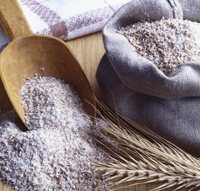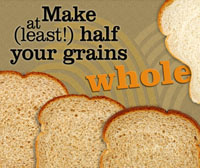Oldways is a nonprofit food and nutrition education organization, inspiring good health through cultural food traditions and lifestyles.
|
|
|
Dear Whole Grains Council members,
Ever wonder how much of the flour in the U.S. food supply is whole wheat?
 The answer is 5.9%, according to a new report from the National Agricultural Statistics Service of the US Department of Agriculture. This breaks down to 6.3% of all common wheat (triticum aestivum) and a much smaller 2% of all durum semolina wheat being milled as whole wheat. While the number is still much smaller than we'd like to see, it's interesting to note that these numbers are about 20% higher than previously estimated -- in part because prior surveys polled only the largest mills, and many smaller mills produce a higher percentage of whole grains. Also keep in mind that these figures are for wheat flour only. We'd be willing to estimate that some flours from other grains are more often sold in whole form than refined. Any millers among our members want to share what percent of their flour is whole grain? We'd be interested. Contact Cynthia Harriman ( cynthia@oldwayspt.org.)
|
| Harley's Tip: Changes in Product Registration Form |
|
Harley Songin, who heads up our Whole Grain Stamp program, wants you to be aware of important updates in the Stamp approval process.  May Tip: We have added a new "total grain" field to the online Product Registration Form (PRF) to allow us to internally calculate the ratio of whole grain in Stamp-registered products. This information will be a routine part of the review and approval process going forward but will not be displayed publicly at this time. We've also moved the space where you upload the required Nutrition Facts Panel, to make it more prominent. We hope both these changes will decrease the number of questions we may have to ask you when reviewing a product, further streamlining the process.
|
| Whole Grains: Top Package Claim in IFIC Survey | | |
 Consumers look for a whole grain claim on packages more often than they look for calories, sugar, sodium, fiber, or any other facts, according to the Food & Health Survey 2015 from IFIC, the International Food Information Council. In fact, 67% of shoppers say that whole grain content helps them make a buying decision. Consumers look for a whole grain claim on packages more often than they look for calories, sugar, sodium, fiber, or any other facts, according to the Food & Health Survey 2015 from IFIC, the International Food Information Council. In fact, 67% of shoppers say that whole grain content helps them make a buying decision.
But what sort of whole grain documentation holds sway with consumers? Sadly, only 7% say they trust a food company or manufacturer to provide accurate information about the types of food they should be eating. That's why a respected, widely-used third-party certification symbol like the Whole Grain Stamp can be so useful in reaching consumers -- 70% of whom say they are trying to consume more whole grains.
One reason whole grains have such great momentum is because people would rather hear what TO eat rather than what NOT TO eat. The IFIC survey found that 78% of people agree or strongly agree with the statement, "I would rather hear what I should eat than what I should not eat." Messages like "fat free" and "low calorie" promise that something desirable has been taken away -- while messages like "100% whole wheat" or "contains 18 grams whole grain" promise you're getting something extra.
You can read our blog summarizing the IFIC survey here, or download the whole survey online.
|
| WGC Comments on US Dietary Guidelines Report | | |
As one of the world's leading whole grain advocacy organizations, one of our key roles is to advise policymakers on sound health and nutrition rules and regulations. Every five years the US government updates its Dietary Guidelines for Americans, a process that includes a preliminary scientific report and a public comment period. Oldways and the Whole Grains Council filed comments on May 1, on whole grains and a few other topics.
 In our comments, we urged that the Dietary Guidelines should continue to recommend Americans make at least half their grains whole. Since the latest (2010) USDA data say we're making only about 12% of our grains whole, there's still a ways to go in cutting out some refined and enriched grains to make room for whole grains within the recommended total grain servings. We also recommended reminding Americans that, in their choices for both whole and refined/enriched grains, it's important to choose intact grains, pasta, and other less-processed options most often, since a whole grain cookie is still a cookie.
In closing, we expressed support for keeping the whole grain guidelines for schools intact. Loosening the rules to require that only half of grain foods be "whole grain rich" means that our kids will be "making one-quarter of their grains whole" -- something not in the kids' best interests and also not in line with federal law that requires all federal nutrition programs to be in accordance with the dietary guidelines.
As always, you can download a copy of our comments on the Official Comments page of the WGC website.
|
| Whole Grain Summit in Portland June 24-26 | |  Cynthia Harriman, Director of Food & Nutrition Strategies for Oldways and the Whole Grains Council, will be speaking about "Translating the Science of Whole Grains to Consumer Messages" at a Whole Grain Summit being held June 24-26 in Portland, OR. The conference, organized by the Moore Family Center for Whole Grain Foods, Nutrition and Preventive Health at Oregon State University and the Grains for Health Foundation, will bring together scientists and other experts from around the world to examine where we've been and where we're going in the area of research on whole grains and health. Although this is not a Whole Grains Council conference, we recommend you check out the program and consider attending. Cynthia Harriman, Director of Food & Nutrition Strategies for Oldways and the Whole Grains Council, will be speaking about "Translating the Science of Whole Grains to Consumer Messages" at a Whole Grain Summit being held June 24-26 in Portland, OR. The conference, organized by the Moore Family Center for Whole Grain Foods, Nutrition and Preventive Health at Oregon State University and the Grains for Health Foundation, will bring together scientists and other experts from around the world to examine where we've been and where we're going in the area of research on whole grains and health. Although this is not a Whole Grains Council conference, we recommend you check out the program and consider attending.
|
| Market with the Mediterranean Diet | |  Looking for a new way to market your whole grain products? Tie them in with the increasingly-popular Mediterranean Diet. The food traditions of countries all around the Mediterranean Sea have a long history of enjoying whole grains in various ways, from barley couscous in Tunisia through tabouleh and other bulgur dishes in the Middle East, to pizzocheri, the buckwheat noodles of Northern Italy. Oldways, the parent organization of the Whole Grains Council, introduced the Mediterranean Diet Pyramid in 1993 and is a leading advocate and education source for the Med Diet. Looking for a new way to market your whole grain products? Tie them in with the increasingly-popular Mediterranean Diet. The food traditions of countries all around the Mediterranean Sea have a long history of enjoying whole grains in various ways, from barley couscous in Tunisia through tabouleh and other bulgur dishes in the Middle East, to pizzocheri, the buckwheat noodles of Northern Italy. Oldways, the parent organization of the Whole Grains Council, introduced the Mediterranean Diet Pyramid in 1993 and is a leading advocate and education source for the Med Diet.
Check out our Mediterranean whole grains summary here and get inspired, because May is International Mediterranean Diet Month. That said, the Med Diet is popular every month!
|
|
Best regards,
Cynthia Harriman
Director of Food and Nutrition Strategies
cynthia@oldwayspt.org
Kelly Toups, MLA, RD, LDN
Program Manager
kelly@oldwayspt.org
Harley Songin
Stamp Program Manager
harley@oldwayspt.org
... and from all of the Oldways and Whole Grains Council staff
|
|
|